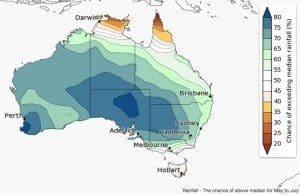Click on image above to watch video explaining the latest three monthly seasonal climate outlook.
 May to July is likely to be wetter than normal over most of Australia, except for the tropical north and Tasmania, according to the Bureau of Meterology’s latest Seasonal Climate Outlook statement released this morning.
May to July is likely to be wetter than normal over most of Australia, except for the tropical north and Tasmania, according to the Bureau of Meterology’s latest Seasonal Climate Outlook statement released this morning.
For May, the Bureau believes large parts of the mainland are likely to be wetter than normal, while western Tasmania and isolated parts of the tropical north have an increased chance of drier conditions.
For May to July, warmer than normal days are likely over the tropical north, southeast and far southwest of Australia. In contrast, cooler than normal days are more likely in a large area from the northwest to central WA, extending across into western NSW.
Night-time temperatures for the season are likely to be warmer than normal over most of Australia, except in the northwest WA, where there is no strong push towards warmer or cooler nights.
The major climate influences for the season ahead are warmer than normal sea surface temperatures in the Indian Ocean and in waters surrounding much of the Australian coastline. In the tropical Pacific, the Bureau’s climate model suggests El Niño is likely to develop over the coming one to two months.
Warmer nights ahead for most of Australia
Daytime temperatures for May to July are likely to be warmer than normal over the tropical north, southeast and far southwest of Australia.
Cooler than normal days are likely in the northwest to central WA extending into western NSW.
Overnight temperatures are likely to be warmer than normal for most of Australia. With the rainfall outlook suggesting wetter weather, this means more cloud is likely to be present, which aids in trapping heat at night.
The major climate influences for the season ahead are warmer than normal sea surface temperatures in the Indian Ocean and that surrounding much of the Australian coastline. In the tropical Pacific, the Bureau’s climate model suggests El Niño is likely to develop over the coming one to two months.
Historical maximum temperature accuracy is moderate to high over Australia. Minimum temperature accuracy is also moderate to high over Australia, except parts of the southeast mainland and the Cape York Peninsula , where skill is low to very low.
Source: BOM



HAVE YOUR SAY